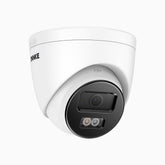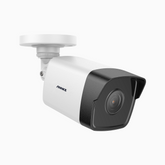The Complete Guide to Installing Wired Security Cameras: From Industry Trends to Hands-On Setup
The Evolution of the Security Industry
Over the past two decades, the video surveillance industry has undergone tremendous transformation. From analog systems with grainy footage to intelligent AI-powered monitoring, the core goal has remained the same — providing clarity, reliability, and peace of mind.

From Analog to IP
Traditional CCTV systems used coaxial cables to transmit analog signals. While stable, they were limited by low resolution, complex wiring, and maintenance difficulties. The introduction of IP (Internet Protocol) cameras marked a milestone — high-definition footage, network-based access, and centralized control became the new standard.
The Rise of PoE Technology
Power over Ethernet (PoE) revolutionized wired security setups by combining power and data transmission in a single cable. This simplified installation while ensuring steady and safe power delivery — a significant step forward in both efficiency and reliability.
The Wireless Surge and Wired Resurgence
With Wi-Fi and 4G technology, wireless cameras quickly gained popularity among homeowners. However, as AI and ultra-high-definition imaging demand greater bandwidth and stability, wired systems are regaining their dominance in both residential and commercial surveillance.
What Is a Wired Camera?
1. Definition and Core Components
A wired camera system generally consists of four key parts:
-
Cameras – capture video footage in real time.
-
Recorder (DVR or NVR) – stores and manages the video.
-
Cables – transmit both power and video signals.
-
Power system – supplies consistent energy for continuous operation.
What truly defines a wired system is how the signal and power are delivered — either through separate cables (as in analog setups) or through a single Ethernet cable (as in PoE systems).
2. The Two Main Categories of Wired Systems
(1) Analog Systems
Analog surveillance systems use coaxial cables (BNC connectors) to transmit video signals to a DVR (Digital Video Recorder). (Explore more: ANNKE Analog Camera)
They typically rely on traditional formats like AHD, TVI, or CVI.
These systems are still widely used for their:
-
Lower cost and broad compatibility with older infrastructure.
-
Reliable wiring that’s less prone to interference.
-
Ease of integration when upgrading existing analog installations.
(2) PoE IP Systems
PoE (Power over Ethernet) camera systems use Ethernet cables (Cat5e/Cat6) to carry both power and data through a single line, connected to an NVR (Network Video Recorder) or PoE switch. (Explore more: ANNKE PoE Camera)
They are ideal for users seeking:
-
High-resolution video — up to 4K or even 12MP.
-
Remote viewing and management via apps or browsers.
-
Advanced AI features, including motion detection, human/vehicle recognition, and smart alerts.
(3). Hybrid Systems (DVR/NVR Combo)
Hybrid systems bridge the gap between analog and IP technologies.
They allow users to connect both coaxial and Ethernet cameras in one unified setup, making them perfect for those upgrading older systems gradually without replacing all existing devices.
Why Wired Cameras Still Matter in the Age of AI
Stability Above All
Unlike Wi-Fi cameras that depend on signal strength and router distance, wired systems deliver uninterrupted data transmission with minimal delay. This makes them ideal for 24/7 monitoring, large properties, and mission-critical sites like warehouses and offices.
Superior Image Quality
Wired PoE systems maintain consistent bitrates even in high-traffic networks, allowing them to support 4K and 8MP footage with true color accuracy and minimal compression loss.
Enhanced Cybersecurity
Since wired cameras operate on closed networks, they’re less vulnerable to hacking or signal jamming. Data stays local unless you choose to enable remote access, offering greater control over privacy.
Long-Term Value
While initial installation costs can be higher than wireless systems, wired setups offer lower long-term maintenance costs and better scalability — new cameras can be easily added via switches without reconfiguring the entire network.
Pre-Installation Planning: Laying the Groundwork
A successful surveillance system starts with clear planning. Before drilling holes or running cables, identify your priorities:
-
Coverage goals – Where do you need visibility most (entrances, driveways, hallways, etc.)?
-
Environment – Indoor, outdoor, or mixed conditions will affect camera choice and cable protection.
-
System type – Decide between PoE NVR systems (data + power through Ethernet) or analog DVR setups if upgrading old infrastructure.
-
Cable route – Keep network lines under 100 meters per run and avoid interference from power cables.
Pro Tip: Always test all devices on the ground before mounting — ensure every camera powers on and displays correctly.
Installation Steps: From Wiring to Live Feed
Step 1: Plan and Run Cables
Use Cat5e or Cat6 Ethernet cables for reliability. Run cables along walls, ceilings, or conduits to protect them from weather or accidental damage. For outdoor installations, use PVC or waterproof tubing to prevent corrosion or UV exposure.
Step 2: Mount Cameras
Position cameras at the right height and angle:
-
Outdoor cameras: around 2.5–3 meters high, under eaves if possible.
-
Indoor cameras: around 2 meters high for optimal coverage.
Preview the live feed via monitor or mobile app to fine-tune viewing angles before final mounting.
Step 3: Connect Devices
-
Plug each camera cable into the PoE ports on the NVR or PoE switch.
-
For non-PoE setups, connect each camera to its power adapter and video input separately.
-
Connect the NVR to a monitor and router using HDMI and Ethernet cables.
Step 4: Power On and Configure
After turning on the NVR:
-
The system should automatically detect connected cameras.
-
If not, manually add them in “Device Management.”
-
Enable DHCP for automatic IP allocation.
-
Configure resolution (1080p/4K), recording modes (continuous or motion-triggered), and H.265+ compression to save storage.
Step 5: Test and Fine-Tune
-
Video clarity: Check each camera for sharpness and color accuracy.
-
Night vision: Turn off lights to ensure infrared or white light activates properly.
-
Motion detection: Walk through monitored zones to test sensitivity.
-
Remote viewing: Connect via mobile app to verify access outside the local network.
Troubleshooting Common Installation Issues
|
Category |
Common Issue |
Possible Cause |
Recommended Fix |
|
Power Supply |
Camera doesn’t power on |
PoE switch output too low, long cable run, damaged adapter |
Check PoE output (≥15W), use shorter/higher-grade cable, or test with a separate power source |
|
Network Connection |
Camera not detected / offline |
Loose cable, IP conflict, port failure |
Reseat cables, restart NVR, reassign IP, or change port |
|
Image Quality |
Blurry or noisy video |
Dirty lens, poor focus, low light |
Clean lens, adjust focus, modify brightness and exposure |
|
Night Vision |
Black screen or overexposed image |
IR malfunction, reflection from nearby surfaces |
Check IR settings, avoid pointing at walls or glass |
|
Recording |
Missing or no footage |
Hard drive unformatted or full |
Format HDD, enable auto overwrite, check recording schedule |
|
Lag / Delay |
Slow live view |
High bitrate, insufficient bandwidth |
Reduce bitrate or upgrade to gigabit switch |
|
Remote Access |
App cannot connect |
Firewall blocks, outdated firmware |
Update app, verify NVR network status, allow external access |
|
Motion Detection |
False alarms or no alerts |
Sensitivity too high/low, zone not set |
Redefine detection area, adjust sensitivity |
|
Audio |
No sound or static noise |
Camera lacks mic, audio channel disabled |
Enable audio input or confirm model supports sound |
|
Time Sync |
Wrong timestamp or order |
Incorrect timezone, no NTP sync |
Set correct timezone, enable auto-sync via NTP |
Maintenance and Future Upgrades
To keep your wired system performing optimally:
-
Clean lenses and inspect wiring every few months.
-
Update firmware regularly for enhanced stability and cybersecurity.
-
Expand smart features like AI motion tracking, dual-light deterrence, or voice alerts as your needs grow.
The Integration and Future of Smart Security
With the rapid advancement of AI, IoT, and cloud computing, wired camera systems are evolving from simple image-capturing devices into central components of an intelligent security ecosystem.
-
AI-Powered Recognition
From basic motion detection to advanced human, vehicle, and pet recognition, wired systems can run complex AI models in real time — thanks to their stable bandwidth and reliable power supply.
-
IoT Connectivity
Modern wired cameras can integrate with door access controls, alarms, and lighting systems to enable event-triggered security responses — for example, activating spotlights or voice alerts when an intrusion is detected.
-
Cloud and Edge Computing Synergy
More NVRs now come equipped with built-in AI chips, supporting edge analytics combined with cloud synchronization. This hybrid approach enhances responsiveness while reducing cloud costs.
-
Expanding Across Home and Business Scenarios
For homeowners, this means a safer and more seamless smart-home experience.
For businesses, it represents a data-driven, centrally managed security infrastructure capable of scaling intelligently with operational needs.
Conclusion: Wired Systems — The Foundation of Smart Security
As the security industry evolves toward AI and IoT, wired cameras remain the backbone of dependable surveillance.
They provide unmatched image quality, network stability, and resilience against external interference — the essential ingredients for a truly intelligent system.
For homeowners, a wired security system delivers enduring peace of mind — a safeguard that silently protects every corner of their property, day and night.
For businesses, it provides the digital backbone of a scalable, data-driven security infrastructure, enabling smarter monitoring, faster response, and long-term operational resilience.
In short, investing in a wired system is not just buying cameras — it’s building a future-ready security network designed to grow with your needs.
















Leave a comment
Please note, comments need to be approved before they are published.